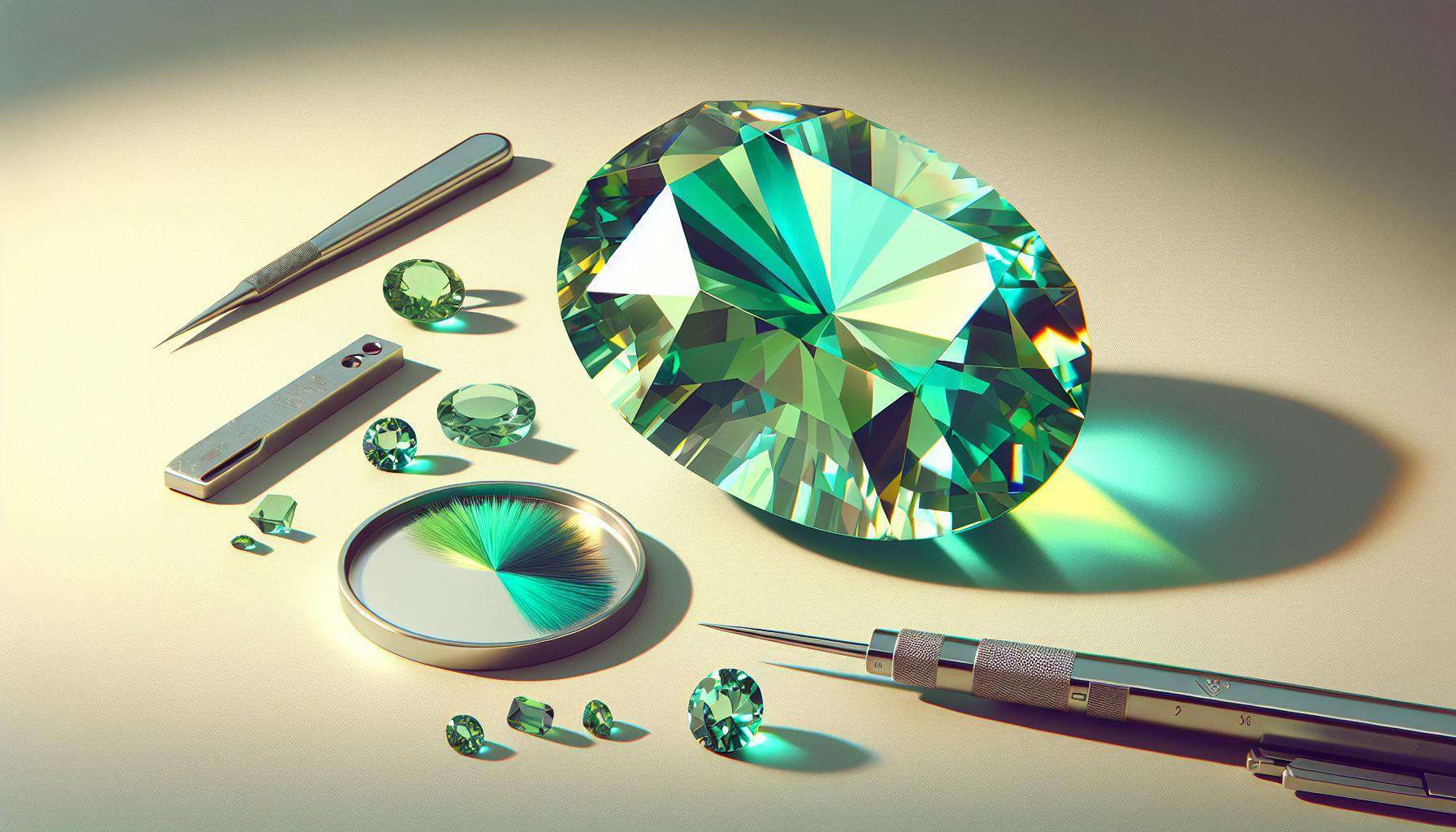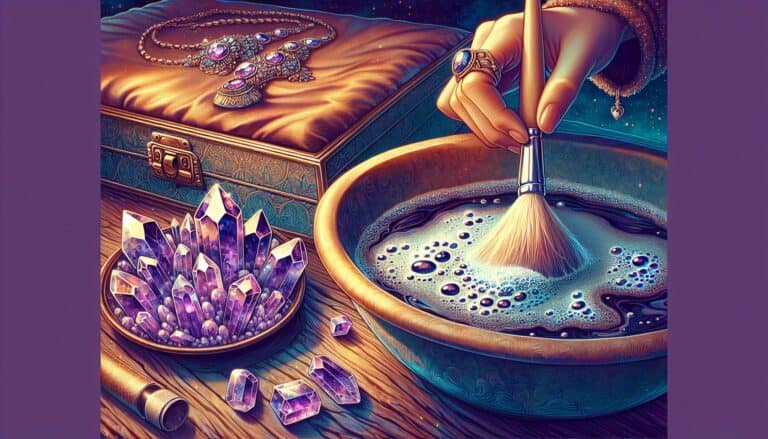Ever stumbled upon a gemstone so captivating, it’s got the serene hues of a tranquil forest?
That’s prasiolite for you, a rare variety of quartz that’s taking the jewelry world by storm. If you’re keen on distinguishing this gem from its many look-alikes, you’re in the right place.
Identifying prasiolite isn’t just about admiring its beauty; it’s about knowing what sets it apart. With its unique green shade, often mistaken for more expensive stones like green amethyst, knowing your prasiolite can save you from a costly mix-up.
Let’s dive into the telltale signs that mark the authenticity of this verdant treasure.
To identify prasiolite, inspect for a soft green hue, glassy luster, and hexagonal crystal structure. True prasiolite leaves a white streak, shows no magnetism, and ranks 7 on the Mohs scale. It exhibits no birefringence, is singly refractive, with an RI of 1.54-1.55, and a specific gravity of about 2.65.
How to Identify Prasiolite Through Testing
When it comes to prasiolite, testing is paramount to ensure you’re getting the real deal. With the right methods, you can separate authentic prasiolite from imposters.
Visual Inspection
Begin by examining the gemstone’s color. True prasiolite should have a soft green hue, unlike the more vivid green of an emerald. Look for uniformity in color throughout the gem, as well as any inclusions that may be characteristic of natural formations.
The Streak Test
Use an unglazed porcelain tile to test the streak. A genuine prasiolite will leave a white streak, not a green one. It’s a quick and non-destructive way to test your gem.
Magnet Test
While prasiolite isn’t magnetic, materials often used to imitate it may be. Run a strong magnet over the gemstone; a lack of reaction supports prasiolite authenticity.
Hardness Test
Using the Mohs hardness scale, prasiolite ranks at about 7. Scratch testing with common items such as a steel file can give you an idea of the gemstone’s hardness.
Birefringence Test
Prasiolite has no birefringence, meaning it should not display a doubling of the back facets when you look through the front of the gemstone. Any doubling effect could indicate a counterfeit.
Checking The Diaphaneity
Examine how light passes through the prasiolite. It should display transparency or at most, translucency. An opaque response might raise a red flag.
Single or Double Refraction
Prasiolite is singly refractive. To test this, immerse the stone in a liquid with a similar refractive index. You shouldn’t see two distinct images of a line drawn beneath.
Refractive Index Test
The refractive index (RI) of prasiolite falls between 1.54 and 1.55. Professional tools such as a refractometer can help you accurately measure this feature.
Finding The Specific Gravity
Determine prasiolite’s specific gravity—which is usually around 2.65—using a hydrostatic balance or electronic scale. This helps to further confirm the gemstone’s identity.
Identifying Prasiolites in the Field
Spotting prasiolite in field conditions requires you to look for well-formed quartz crystals with the characteristic green tint. This is often in geodes or veins within rocks.
Recognizing Potential Prasiolite Rocks
In their natural setting, prasiolites may be encased in rocks with a smoky or clear quartz matrix. They often reside in places where other quartz varieties are found, and spotting a greenish hue among them could be a sign of prasiolite.
Equip yourself with these testing techniques, and you’ll be more than capable of discerning the true nature of your prasiolite. From visual inspection to complex testing methods, each step gets you closer to verification. Make sure to handle all tests with care to preserve the value and integrity of your prasiolite gemstone.
Physical Characteristics of Prasiolite

Understanding prasiolite’s physical attributes is vital when you’re trying to identify this particular gemstone. Prasiolites boast a distinct appearance, setting them apart from other quartz varieties. They typically exhibit a pale green to a deep olive green hue, a result of heat treatment or natural irradiation of amethyst or yellowish quartz.
Color consistency throughout the crystal is a hallmark of prasiolite. You’ll notice the color is relatively uniform, which is a key differentiator from dyed stones that often have color concentrations at certain points. When prasiolite is held against the light, its color may appear more intense, providing you with a clue about its identity.
The stones also show well-defined crystal faces and sharp edges, a characteristic of the hexagonal crystal system. This structure is not only indicative of prasiolite but of quartz minerals in general. The crystal termination points are typically pyramidal, which helps distinguish them from other gemstones.
In terms of luster, prasiolites have a glass-like quality, referred to as vitreous. This sheen contributes to their visual appeal and is another aspect you should look for. Lastly, don’t forget to weigh prasiolite’s density. Though prasiolites are not significantly heavier than other stones, their specific gravity sets them apart with measurements around 2.65 g/cm³, which aligns with other quartz varieties.
Keep these physical features in mind as you handle and inspect potential prasiolite specimens. Their unique combination of color, crystal structure, and luster are telling characteristics that aid in the identification process.
How Are Prasiolite Formed?
Prasiolite, a rare form of green quartz, isn’t typically formed in nature. In fact, most prasiolite you’ll encounter has been artfully crafted through a heat treatment process. Natural prasiolite does occur, but it’s almost always the result of heat from volcanic activity or other natural geothermal conditions transforming amethyst or yellowish quartz. Imagine the earth’s raw power catalyzing this stunning transformation.
- Natural Creation: When naturally occurring, prasiolite forms in iron-rich volcanic rocks. The presence of ferrous iron is key, as it’s the iron that gives prasiolite its green color.
- Heat Treatment: Artificially, it’s far more common to create prasiolite by heating amethyst. Temperatures between approx. 500 to 600 degrees Celsius are used to initiate this process.
The natural creation of prasiolite is rare, perfecting its unique appeal. Miners excavate potential prasiolite-bearing rocks, usually where tinges of green hint at its presence. For jewelers and collectors, whether formed by the hand of nature or through human ingenuity, prasiolite remains a prized and sought-after gemstone.
Understanding these formation processes not only satisfies curiosity but also enriches the appreciation for each prasiolite’s journey from a mere component in the earth to a treasured piece in someone’s collection. As you delve into the origins of your prasiolite, you become part of its history.
Preparation for Prasiolite Hunting
When planning to scout for prasiolite, adequately preparing can make the difference between a fruitful outing and a fruitless one. You’ll need the right tools and a mindset geared towards safety to navigate your hunting grounds effectively.
Gathering the Right Tools
Before heading out, ensure you’ve got all the necessary equipment. Your toolbox should include:
- A sturdy hammer for breaking rocks;
- Protective goggles to shield your eyes from flying debris;
- A set of chisels in various sizes for detailed work;
- A geologist’s pick for a multipurpose digging and scraping tool;
- A UV light, as some prasiolite may fluoresce under ultraviolet light;
- Durable gloves to protect your hands from sharp edges;
- A magnifying glass or loupe to closely examine potential finds;
- Field guides or maps, especially if you’re searching in less familiar areas.
This toolkit won’t just aid in uncovering prasiolite but can also help confirm the gemstone’s authenticity once you’ve found potential samples.
Safety Considerations
Your safety should always be your top priority. Before venturing out:
- Make sure to inform someone about your trip, including your destination and expected return time.
- Check the weather forecast; you don’t want to be caught in a storm while searching.
- Wear appropriate clothing and footwear; conditions can be rugged, so comfort and protection are key.
- Bring sufficient water and snacks to stay hydrated and maintain energy levels.
- Carry a first-aid kit for any minor injuries you might encounter.
- Be aware of local wildlife and know how to respond to encounters.
- Lastly, respect the environment and follow the leave-no-trace principles to preserve the natural beauty for others.
Arm yourself with the proper tools and knowledge, and you’ll be well on your way to uncovering the beauty of prasiolite in the wild. Remember, it’s not just about the gemstone—you’re also there to enjoy the journey and the thrill of the hunt.
Handling and Care of Found Prasiolite

Cleaning Prasiolites
Once you’ve successfully identified and collected prasiolite from the field, it’s essential to clean your finds to reveal their true beauty. Start by rinsing your prasiolites in lukewarm water to remove any loose dirt and dust. For tougher grime, you can use a soft-bristled brush; however, make sure it’s gentle enough to avoid scratching the stone’s surface. Soaking the stone in warm, soapy water is another effective method. Use a mild detergent and ensure the soap is thoroughly rinsed off afterward.
If your prasiolite has stubborn deposits, an ultrasonic cleaner could be your next step. But be cautious; not all gemstones are suited for ultrasonic cleaning, and you should always consult with a professional if you’re unsure whether it’s safe for your prasiolite. Lastly, dry your gems with a soft, lint-free cloth to prevent water spots.
Storing Prasiolites
Proper storage is paramount to maintain the condition of your prasiolite treasures:
- Store each prasiolite in a separate pouch or compartment to prevent scratching. Prasiolite may be hard, but it can still be scratched by other materials.
- Wrap each stone in a soft cloth or place it inside a fabric-lined jewelry box.
- Avoid exposing your prasiolite to extreme temperatures and chemicals that could damage the stone.
- Keep your prasiolite away from direct sunlight for prolonged periods as UV rays can potentially affect the color.
Remember, your prasiolite is not only a reflection of nature’s beauty but also a testament to your hard work in identifying and collecting it. Handle it with care to preserve its lustre and brilliance for years to come.
Conclusion: Confirming Prasiolite is Real
Mastering the art of identifying prasiolite ensures you can appreciate the true beauty and value of this gemstone.
Remember, a keen eye for color and crystal structure, coupled with the outlined tests for authenticity, are your best tools. Handling your prasiolite with the care it deserves, from cleaning to storage, will maintain its luster and prevent damage.
Cherish the unique charm of your prasiolite finds and enjoy the confidence that comes with knowing you’ve got the real deal.




![Virginia Rockhounding Sites in [year]: Guide & Finds](https://observationhobbies.com/wp-content/uploads/2024/01/GLmeOzdUxOYuYKnhLJv6g-768x439.jpg)
![NH Rockhounding Sites in [year]: Spots & Treasures](https://observationhobbies.com/wp-content/uploads/2024/01/7XT_yRWhzhwbBRthKOCkS-768x439.jpg)

![NC Rockhounding Sites in [year]: Locations & Treasures](https://observationhobbies.com/wp-content/uploads/2024/01/7WYi0Mp8byhR-Iby7aEaJ-768x439.jpg)